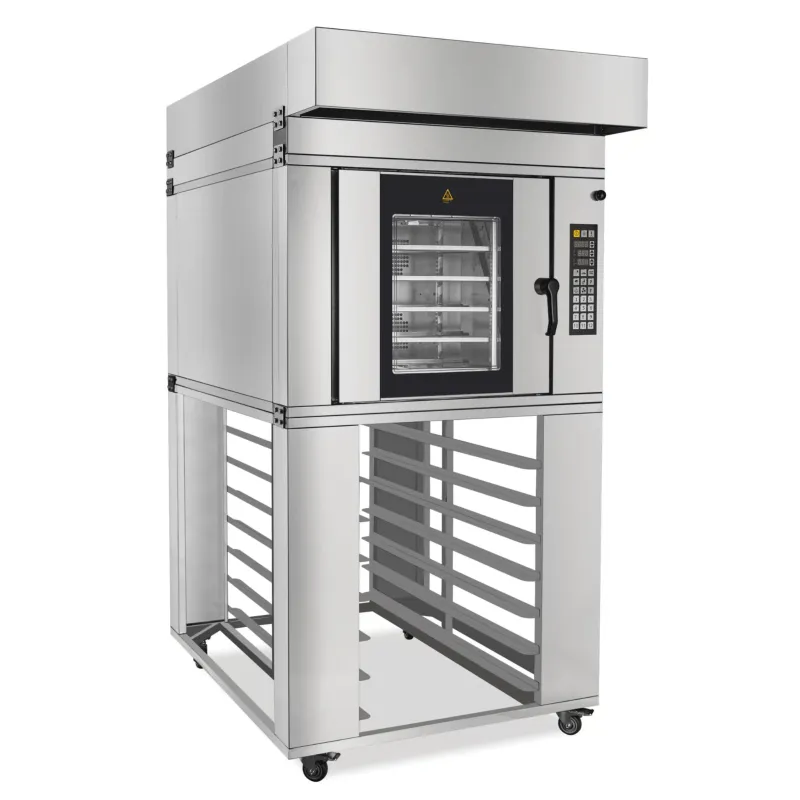การทำงานของเทคโนโลยีเตาอบคอนเวกชันในร้านเบเกอรี่
เตาอบแบบคอนเวคชันเปลี่ยนวิธีการอบของเราไปอย่างแท้จริง เพราะมันพัดลมเพื่อหมุนเวียนอากาศร้อนภายในด้วยพัดลมในตัว ทำให้อาหารสุกได้สม่ำเสมอกว่าและมีสีน้ำตาลสม่ำเสมอทั่วทั้งชิ้น หลักการทำงานของเตาเหล่านี้ก็ง่ายๆ เอง — มันมีเพียงพัดลมภายในที่คอยหมุนเวียนอากาศร้อนอย่างต่อเนื่องรอบๆ สิ่งที่เรากำลังอบอยู่ ซึ่งหมายความว่าความร้อนถูกถ่ายเทได้เร็วกว่าเมื่อเทียบกับเตาอบธรรมดาที่ความร้อนมักจะนิ่งอยู่กับที่ การทำให้อาหารสุกเร็วขึ้นไม่ใช่ประโยชน์เพียงอย่างเดียวเท่านั้น เตาอบแบบนี้ยังช่วยลดการสูญเสียความชื้นของอาหารขณะอบ ซึ่งมีความสำคัญมากเมื่อทำขนมอบหรือขนมปังที่เน้นเนื้อสัมผัสเป็นพิเศษ เชฟเบเกอรี่มืออาชีพหลายคนยังยืนยันถึงคุณภาพของเตาอบคอนเวคชันอีกด้วย พวกเขาพูดถึงการที่การไหลเวียนอากาศอย่างต่อเนื่องช่วยให้ผลลัพธ์ระหว่างแต่ละรอบอบมีความสม่ำเสมอได้มากกว่า สิ่งที่ผู้คนทั่วไปมักประสบปัญหาเมื่อใช้เตาอบมาตรฐาน นั่นจึงเป็นเหตุผลว่าทำไมร้านเบเกอรี่ส่วนใหญ่จึงพึ่งพาเตาแบบคอนเวคชันในการดำเนินงานประจำวัน มันช่วยให้การทำงานในครัวสะดวกขึ้น พร้อมทั้งให้ผลลัพธ์ที่มีคุณภาพและรสชาติดีเยี่ยมทุกครั้ง
ความสม่ำเสมอของอุณหภูมิในแต่ละชั้น
ความสม่ำเสมอของอุณหภูมิคือสิ่งที่ทำให้เตาอบแบบคอนเวคชันมีความโดดเด่นเมื่อพูดถึงการทำเบเกอรี่ที่ให้ผลลัพธ์เชื่อถือได้จากชั้นวางหนึ่งไปยังอีกชั้นวางหนึ่ง เตาอบธรรมดาโดยทั่วไปมักมีจุดร้อนที่น่ารำคาญ ซึ่งทำให้อาหารบางส่วนของแต่ละรอบอบสุกเร็วกว่าส่วนอื่น ๆ แต่เตาแบบคอนเวคชันสามารถรักษาอุณหภูมิภายในให้สม่ำเสมอได้ดีกว่า ซึ่งหมายความว่าโอกาสที่จะพบว่าขอบขนมไหม้ในขณะที่ตรงกลางยังไม่สุกนั้นมีน้อยมาก ผู้ที่เปลี่ยนมาใช้เตาอบแบบคอนเวคชันมักจะสังเกตเห็นความแตกต่างของคุณภาพสินค้าที่ออกมาอย่างชัดเจน นอกจากนี้ ข้อมูลจากการศึกษาของสถาบันสอนทำอาหารและครัวเชิงพาณิชย์ยังยืนยันเรื่องนี้เช่นเดียวกัน ซึ่งเป็นเหตุผลว่าทำไมผู้เชี่ยวชาญจำนวนมากจึงพึ่งพาเตาอบชนิดนี้ในทุก ๆ วัน นอกเหนือจากเรื่องรสชาติที่ดีขึ้นแล้ว อุณหภูมิที่คงที่ยังช่วยประหยัดเวลาในการผลิต จึงอธิบายได้ว่าทำไมเบเกอรี่สมัยใหม่ส่วนใหญ่จึงไม่มีทางกลับไปใช้เตาอบรูปแบบดั้งเดิมอีก
เวลาอบที่เร็วขึ้นเพื่อการผลิตที่เพิ่มขึ้น
เวลาในการปรุงอาหารน้อยลงเมื่อเทียบกับเตาอบทั่วไป
เตาอบแบบคอนเวคชันทำให้การอบอาหารมีประสิทธิภาพมากขึ้น เพราะสามารถทำให้อาหารสุกเร็วกว่าเตาอบทั่วไปมาก หลักการทำงานนั้นค่อนข้างเรียบง่าย ซึ่งก็คือการเป่าลมร้อนให้ไหลเวียนรอบอาหารที่กำลังอบอยู่ภายใน ผู้ใช้งานส่วนใหญ่พบว่าเวลาในการอบลดลงได้ประมาณหนึ่งในสี่เมื่อเทียบกับวิธีการแบบดั้งเดิม ความประหยัดเวลาแบบนี้มีความสำคัญอย่างมากสำหรับการดำเนินงานเชิงพาณิชย์ เพราะร้านเบเกอรี่สามารถผลิตสินค้าได้มากขึ้นตลอดทั้งวัน โดยไม่จำเป็นต้องเพิ่มอุปกรณ์หรือพนักงานเพิ่มเติม พนักงานเองก็สามารถผลิตสินค้าได้มากขึ้น พร้อมทั้งรักษามาตรฐานคุณภาพไว้ได้ ลูกค้าก็สามารถรับสินค้าได้รวดเร็วขึ้น ซึ่งช่วยให้ลูกค้าเกิดความพึงพอใจ และลูกค้าที่พึงพอใจมักจะกลับมาซื้อซ้ำอีก ดังนั้นในระยะยาว ธุรกิจจึงสามารถเพิ่มยอดขายได้ดีขึ้นด้วย
ความสามารถในการอบหลายชั้นพร้อมกัน
เตาอบแบบคอนเวคชันมีข้อดีอีกประการหนึ่งที่สำคัญ คือสามารถอบหลายชั้นได้พร้อมกันในขณะที่ยังคงคุณภาพของเบเกอรี่ให้อร่อยเหมือนเดิม สำหรับร้านเบเกอรี่ที่ต้องรับมือกับคำสั่งซื้อขนาดใหญ่ เช่น คุกกี้ เค้ก และขนมปังก้อน ข้อดีนี้มีความสำคัญอย่างมาก จากประสบการณ์จริงแสดงให้เห็นว่าเมื่อผู้ผลิตสามารถทำงานกับหลายชั้นแทนที่จะเป็นเพียงชั้นเดียว ปริมาณการผลิตมักเพิ่มขึ้นเกือบเป็นสองเท่า ซึ่งการเพิ่มขึ้นในลักษณะนี้ทำให้เตาอบแบบคอนเวคชันเป็นทางเลือกที่เหมาะสมสำหรับทุกธุรกิจที่ต้องการเติบโต แต่ข้อดีที่แท้จริงไม่ได้อยู่ที่ความเร็วเพียงอย่างเดียวเท่านั้น แต่ยังอยู่ที่การให้ความร้อนที่ทั่วถึงในทุกชั้น จึงไม่มีสินค้าชิ้นใดออกมาไม่สุกหรือสุกเกินไป ลูกค้าสามารถรับรู้ถึงความแตกต่างด้านคุณภาพเหล่านี้ ซึ่งจะช่วยให้พวกเขากลับมาซื้อซ้ำ
ประหยัดพลังงานและค่าใช้จ่าย
ความต้องการอุณหภูมิต่ำกว่า
เตาอบคอนเวกชันส่วนใหญ่ต้องใช้อุณหภูมิในการปรุงอาหารที่ต่ำกว่าเตาอบทั่วไป ซึ่งช่วยลดการใช้พลังงานในระยะยาว การศึกษาด้านพลังงานแสดงให้เห็นว่าร้านเบเกอรี่ที่เปลี่ยนมาใช้เตาแบบคอนเวกชันโดยทั่วไปจะมีค่าไฟฟ้าลดลงประมาณ 20% แต่ประโยชน์ที่ได้มีมากกว่าแค่การประหยัดเงินเท่านั้น ความร้อนที่ลดลงนี้มักจะช่วยให้อาหารสุกอย่างสม่ำเสมอ ทำให้ขนมอบและขนมปังมีเนื้อสัมผัสและลักษณะภายนอกที่ดีขึ้น ซึ่งลูกค้าสามารถสังเกตเห็นได้ทันที ผู้ประกอบการร้านเบเกอรี่ขนาดเล็กหลายรายรายงานว่าหลังจากติดตั้งเตาอบคอนเวกชันแล้ว พวกเขาได้รับคำร้องเรียนเกี่ยวกับผลิตภัณฑ์ที่ไม่สุกลดลง และสามารถขายสินค้าได้มากขึ้น เนื่องจากสินค้ามีลักษณะสดใหม่และรสชาติดีขึ้น สำหรับธุรกิจที่ต้องการลดต้นทุนโดยไม่สูญเสียคุณภาพ เตาอบเหล่านี้ให้คุณค่าที่แท้จริงทั้งในแง่ของรายจ่ายและระดับความพึงพอใจของลูกค้า
รูปแบบการบริโภคพลังงานที่ลดลง
การเปลี่ยนไปใช้เตาอบแบบคอนเวคชันนั้น ช่วยลดการใช้พลังงานตลอดทั้งวัน ซึ่งเป็นการช่วยปกป้องโลกและยังช่วยให้เจ้าของร้านเบเกอรี่ประหยัดค่าใช้จ่ายไปในตัวด้วย ร้านเบเกอรี่ท้องถิ่นเล่าให้ฟังถึงการลดปริมาณคาร์บอนฟุตพรินต์ (carbon footprint) ของพวกเขา เพียงเพราะโมเดลใหม่เหล่านี้ใช้พลังงานในการทำงานน้อยลง การหันมาใช้อุปกรณ์ที่มีประสิทธิภาพเพื่อการอนุรักษ์สิ่งแวดล้อมนั้นมีความสำคัญอย่างมากในสถานการณ์ด้านสภาพภูมิอากาศทั่วโลกในปัจจุบัน ดังนั้นร้านค้าจำนวนมากจึงเริ่มแสดงหลักปฏิบัติด้านความยั่งยืนของตนอย่างภาคภูมิใจไว้ที่หน้าต่างร้านค้าของพวกเขาเอง ลูกค้าก็สังเกตเห็นเรื่องพวกนี้เช่นกัน คนที่ใส่ใจเรื่องการรักษาสิ่งแวดล้อมมักจะสนับสนุนธุรกิจที่มีค่านิยมตรงกัน และเมื่อเห็นว่าร้านเบเกอรี่แห่งหนึ่งกำลังทำส่วนของตนเองเพื่อสิ่งแวดล้อมโดยไม่ลดทอนคุณภาพของผลิตภัณฑ์ ข่าวนี้ก็จะเผยแพร่ออกไปอย่างรวดเร็ว

ความหลากหลายสำหรับขนมปังและขนมอบชนิดต่างๆ
ประสิทธิภาพที่เหมาะสมสำหรับขนมปังและขนมอบ
ผู้ที่ชื่นชอบขนมปังและขนมอบต่างทราบดีว่าเตาอบแบบคอนเวคชันสร้างสภาพแวดล้อมในการอบที่ยอดเยี่ยมด้วยความหลากหลายในการใช้งานสำหรับของอบทุกประเภท สิ่งที่ทำให้เตาอบเหล่านี้พิเศษคือ การหมุนเวียนอากาศตลอดช่องเตาอบอย่างสม่ำเสมอ ทำให้ความร้อนกระจายตัวได้อย่างทั่วถึงสำหรับสิ่งที่อยู่ด้านใน สิ่งนี้มีความสำคัญมากเมื่อพยายามให้ได้เปลือกนอกสีทองที่เหมาะสมที่สุดสำหรับขนมปังฝรั่งเศษหรือครัวซองต์ ผู้ที่อบขนมในบ้านยังรายงานอีกว่าให้ผลลัพธ์ที่มีรสชาติดีกว่าด้วยเนื้อสัมผัสที่เหนือกว่าเตาอบทั่วไปอีกด้วย อีกหนึ่งสิ่งที่ยอดเยี่ยมเกี่ยวกับเตาอบแบบคอนเวคชันคือ ความสามารถในการจัดการความชื้นระหว่างการอบ โดยเฉพาะสำหรับการทำขนมปัง หมายความว่าแป้งสามารถขยายตัวได้อย่างเหมาะสมโดยไม่แห้งหรือเหนียวเกินไป พ่อครัวแม่บ้านมักประหลาดใจว่าขนมปังที่มีคุณภาพระดับมืออาชีพสามารถออกมาจากเตาอบในครัวของตนเองได้ เมื่อใช้เตาอบแบบคอนเวคชัน
ความสามารถในการปรับตัวสำหรับคุกกี้และรายการที่ละเอียดอ่อน
เตาอบแบบคอนเวคชันทำงานได้ดีมากสำหรับอาหารอบที่ต้องการความแม่นยำ เช่น คุกกี้และซูเฟล ด้วยการกระจายความร้อนอย่างอ่อนโยนทั่วทั้งห้องอบ สำหรับเจ้าของร้านเบเกอรี่ที่ต้องการทดลองสูตรใหม่โดยไม่ต้องกังวลเรื่องความผิดพลาด คุณสมบัตินี้ถือเป็นตัวเปลี่ยนเกม เมื่อสถานที่ใดติดตั้งเตาอบคอนเวคชันแล้ว พวกเขาสามารถขยายเมนูที่ให้บริการได้จริง โดยไม่ต้องพบเจอกับปัญหาอาหารบางส่วนไหม้ในขณะที่อีกส่วนยังไม่สุก ผลลัพธ์ที่ได้คือ จำนวนของผลิตภัณฑ์ที่เสียหายลดลง และความสม่ำเสมอที่ดีขึ้นมากในทุกขนมอบที่ออกจากเตา ลูกค้ามักสังเกตเห็นถึงการปรับปรุงเหล่านี้เช่นกัน ซึ่งหมายความว่าธุรกิจจะได้รับข้อร้องเรียนและการคืนสินค้าน้อยลง นอกจากนี้ พนักงานทำขนมยังสามารถทดลองสร้างสรรค์สิ่งใหม่ๆ ได้อย่างมั่นใจ ด้วยความรู้ว่าอุปกรณ์ของพวกเขาสามารถจัดการกับทุกสิ่งที่ท้าทายได้ พร้อมทั้งรักษามาตรฐานคุณภาพระดับสูงตามที่ลูกค้าคาดหวังทุกครั้ง
การปรับปรุงคุณภาพและความสม่ําเสมอของผลิตภัณฑ์
การ caramelizing และการพัฒนาเปลือกที่สม่ำเสมอ
เตาอบแบบคอนเวคชันกระจายความร้อนได้ค่อนข้างสม่ำเสมอทั่วทั้งห้องอบ ทำให้อาหารที่อบมีสีน้ำตาลสม่ำเสมอทั่วทุกด้าน ผู้ที่ทำขนมปังแบบอาร์ติซานชื่นชอบคุณสมบัตินี้เป็นพิเศษ เนื่องจากเปลือกขนมปังมีบทบาทสำคัญมากต่อการที่ขนมปังออกมาดูดีและมีรสชาติอร่อย ความน้ำตาลที่เกิดขึ้นบนเปลือกขนมปังไม่ได้มีดีแค่เรื่องหน้าตาเท่านั้น แต่ยังช่วยเพิ่มพูนรสชาติอีกด้วย ลูกค้าส่วนใหญ่ต้องการขนมปังที่ทั้งดูดีและมีรสชาติเยี่ยม และเตาอบแบบคอนเวคชันสามารถผลิตเปลือกสีทองนี้ออกมาได้อย่างสม่ำเสมอไม่มีผิดพลาด ผู้ที่ทำขนมปังต่างรู้ดีว่าการสีไม่สม่ำเสมอ อาจทำให้ขนมปังที่ยอดเยี่ยมดูน่าสนใจน้อยลงในสายตาของผู้ซื้อ
ลดปัญหาจุดร้อน/จุดเย็น
ข้อดีอันใหญ่หลวงของเทคโนโลยีเตาอบแบบคอนเวคชันคืออะไร? มันช่วยลดจุดร้อนและจุดเย็นที่เราคุ้นเคยกันดีจากเตาอบธรรมดา หลักการทำงานของเตาอบชนิดนี้ที่ทำให้อากาศร้อนหมุนเวียนทั่วทั้งเตา ช่วยให้อาหารสุกอย่างสม่ำเสมอ ลองคิดถึงการอบหลายถาดพร้อมกัน – ไม่ต้องเดาอีกต่อไปว่าของสุกดีหรือยัง สำหรับผู้ที่ทำเบเกอรี่แล้ว ความสม่ำเสมอแบบนี้มีความหมายมาก พวกเขาสามารถมั่นใจได้ว่าสินค้าของตนจะออกมาดีสม่ำเสมอในทุกๆ ล็อต ทำให้ลูกค้ากลับมาซื้อซ้ำ ล่าสุดเมื่ออาทิตย์ก่อน เจ้าของร้านเบเกอรี่แห่งหนึ่งเล่าให้ฟังว่า การเปลี่ยนมาใช้เตาอบคอนเวคชันช่วยประหยัดค่าใช้จ่ายจากของเสีย และยังคงรสชาติของคุกกี้ช็อกโกแลตชิปสูตรพิเศษไว้ได้อย่างที่ลูกค้าชื่นชอบ
ข้อได้เปรียบของการขยายขนาดเบเกอรี่เชิงพาณิชย์
ความสามารถในการผลิตปริมาณมาก
เตาอบแบบคอนเวคชันได้ถูกออกแบบมาเพื่อการผลิตจำนวนมาก ซึ่งเป็นเหตุผลว่าทำไมมันจึงเหมาะสำหรับใช้ในร้านเบเกอรี่เชิงพาณิชย์ที่ต้องมีสินค้าออกมาอย่างสม่ำเสมอ เครื่องเหล่านี้สามารถรองรับถาดอบหลายชั้นพร้อมกันได้ บางรุ่นสามารถวางได้ถึงหกหรือแปดถาดต่อครั้งขึ้นอยู่กับขนาด ช่วยให้เบเกอรี่สามารถผลิตสินค้าได้รวดเร็วกว่าวิธีการแบบดั้งเดิม จุดเด่นที่แท้จริงคือกระบวนการอบที่ทำได้พร้อมกันทั้งหลายชั้น เบเกอรี่ที่ใช้เทคโนโลยีคอนเวคชันรายงานว่าสามารถเพิ่มปริมาณการผลิตเป็นสองเท่าในช่วงเวลาเร่งด่วน โดยไม่สูญเสียคุณภาพด้านรสชาติหรือเนื้อสัมผัส และพูดตามจริงแล้ว ไม่มีใครต้องการให้คุกกี้ไหม้หรือพายไม่สุกในขณะที่ลูกค้ายังคงต่อคิวรออยู่หน้าประตู นี่จึงเป็นสิ่งที่ทำให้เตาอบคอนเวคชันกลายเป็นเครื่องมือเปลี่ยนเกมสำหรับธุรกิจที่พยายามรักษาสมดุลระหว่างความรวดเร็วและความสูงส่งของคุณภาพ
การจัดวางพื้นที่ผ่านการอบแบบตั้งฉาก
เตาอบคอนเวคชั่นถูกออกแบบให้ร้านขนมสามารถใช้พื้นที่ตั้งได้ดี ซึ่งเป็นสิ่งสําคัญมาก เมื่อห้องครัวมีขนาดใหญ่ การวางเตาเหล่านั้นไว้ด้วยกัน หมายความว่าคนทําขนม จะได้ผลประโยชน์มากกว่า จากเตาอบแต่ละเตา โดยไม่ใช้พื้นที่เพิ่มขึ้นบนพื้น ซึ่งเป็นสิ่งที่ตรงกับแนวโน้มในปัจจุบัน ในการประหยัดพื้นที่ในร้านขนมในเมือง และครัวขนาดเล็ก เมื่อร้านขนมปังอัตโนมัติพื้นที่นี้ ให้มีประสิทธิภาพมากขึ้นในชีวิตประจําวัน และยังลดต้นทุนด้วย เพราะไม่ต้องใช้อาคารใหญ่ๆ หรืออุปกรณ์เสริม เพียงแค่เพื่อจัดการกับขนมปังที่มากกว่า ลองดูร้านขนมปังเมืองที่ประสบความสําเร็จทุกวันนี้ และโอกาสที่มันจะคิดออกว่า จะดึงทุกซมสุดท้ายออกจากเตาอบปักปังของมันอย่างไร
คำถามที่พบบ่อย
เตาอบแบบคอนเวกชันใช้ทำอะไรในร้านเบเกอรี่?
เตาอบแบบคอนเวกชันใช้ในร้านเบเกอรี่เพื่อให้แน่ใจว่าอาหารอบจะสุกและมีสีเหลืองกรอบสม่ำเสมอ พร้อมมอบผลลัพธ์การอบที่คงที่ในแต่ละชั้น และช่วยเพิ่มประสิทธิภาพและความรวดเร็วในการทำงาน
เตาอบแบบคอนเวกชันช่วยเพิ่มประสิทธิภาพการใช้พลังงานอย่างไร?
เตาอบแบบคอนเวกชันทั่วไปต้องการอุณหภูมิในการปรุงอาหารที่ต่ำกว่าและมีรูปแบบการใช้พลังงานที่มีประสิทธิภาพมากขึ้น มอบการประหยัดพลังงานอย่างมหาศาลเมื่อเทียบกับเตาอบแบบดั้งเดิม
เตาอบแบบคอนเวกชันสามารถจัดการถาดอบหลายถาดพร้อมกันได้หรือไม่?
ใช่ เตาอบแบบคอนเวกชันสามารอบถาดหลายถาดพร้อมกันได้โดยไม่ลดคุณภาพของสินค้าอบ ทำให้เพิ่มอัตราการผลิตได้อย่างมีประสิทธิภาพ
เตาอบแบบคอนเวกชันมีผลกระทบต่อเนื้อสัมผัสและรสชาติของสินค้าอบหรือไม่?
เตาอบแบบคอนเวกชันสร้างการไหลเวียนของอากาศที่สม่ำเสมอ ซึ่งช่วยให้มีการกระจายความร้อนที่เท่าเทียมกัน พัฒนาเปลือกขนมให้เหมาะสม และยังเสริมทั้งรสชาติและเนื้อสัมผัสของสินค้าอบ

